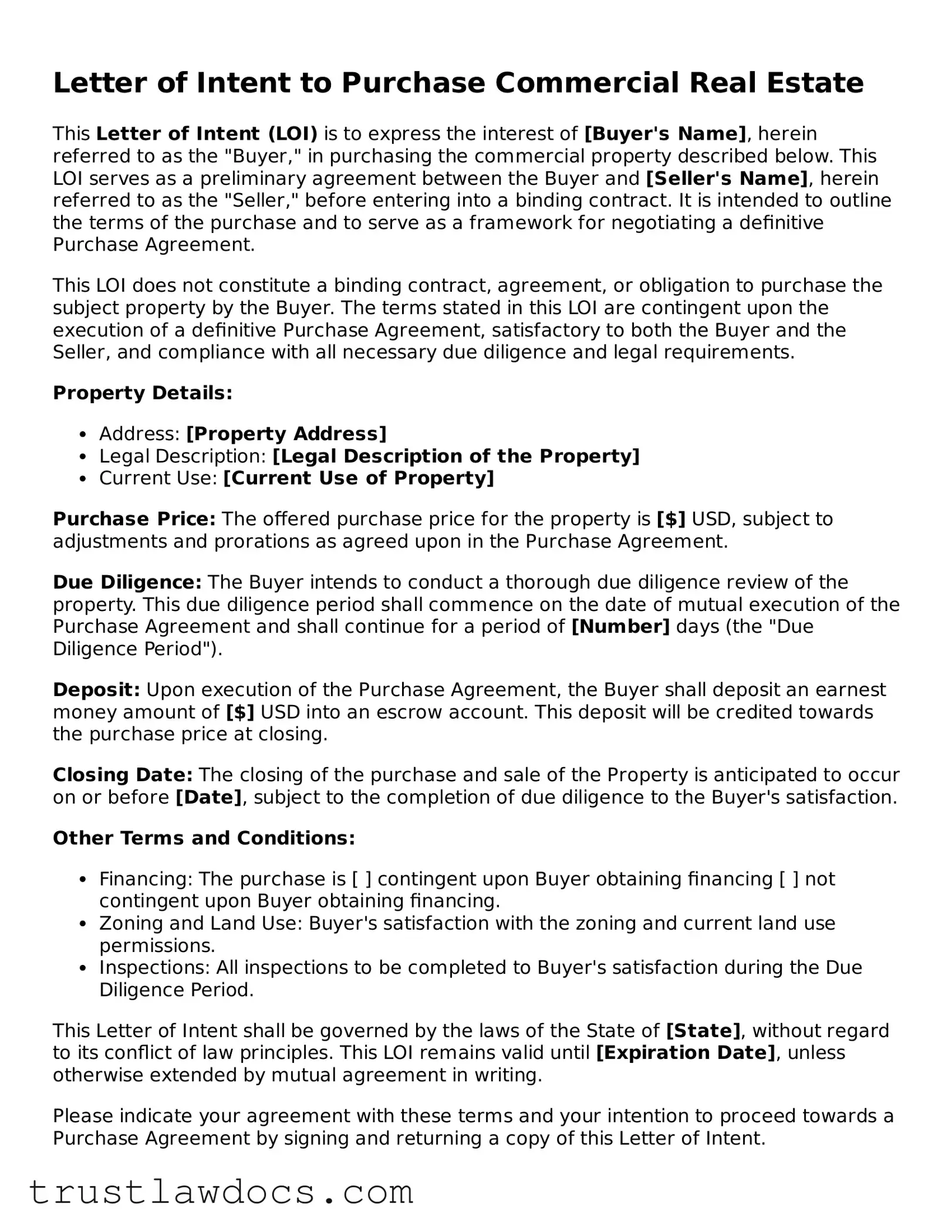What is a Letter of Intent to Purchase Commercial Real Estate?
A Letter of Intent (LOI) to Purchase Commercial Real Estate is a preliminary agreement between a buyer and a seller indicating the buyer's interest in purchasing the property. This document outlines the basic terms and conditions of the proposed transaction, including price, due diligence periods, and closing conditions, before entering into a binding contract. It serves to align both parties' expectations and acts as a foundation for negotiating a formal purchase agreement.
Is a Letter of Intent legally binding?
Generally, a Letter of Intent itself is not legally binding in terms of the obligation to purchase or sell the property. However, certain provisions within, such as confidentiality, exclusivity, and governing law clauses, can be binding. It is crucial to clearly specify which parts are intended to be binding to avoid unintended legal obligations.
What key terms are included in a Letter of Intent?
A typical Letter of Intent to Purchase Commercial Real Estate includes terms such as the purchase price, deposit amount, due diligence period, anticipated closing date, description of the property, and any contingencies that the purchase is subject to. It may also address matters like title issues, financing terms, and the allocation of closing costs.
How can I ensure that my Letter of Intent is taken seriously?
To ensure that your Letter of Intent is taken seriously, present a clear, concise, and professionally formatted document. Include all relevant terms and show your commitment to the transaction through earnest money deposits or proof of funds. Demonstrating a willingness to move forward quickly on due diligence and closing processes can also convey seriousness.
Can either party back out after signing a Letter of Intent?
Yes, either party can typically back out after signing a Letter of Intent since it is not usually a binding agreement to purchase or sell. Nonetheless, if there are binding provisions within the LOI, such as exclusivity or confidentiality clauses, these must still be adhered to regardless of the decision to proceed with the purchase.
What happens after a Letter of Intent is signed?
After signing a Letter of Intent, both parties generally proceed with due diligence. This phase involves thorough examination of the property, reviewing legal, environmental, and structural aspects, among others. Concurrently, the formal Purchase and Sale Agreement (PSA) is negotiated. The findings from the due diligence process can impact the final terms of the PSA.
Can a Letter of Intent be negotiated?
Absolutely. A Letter of Intent serves as an initial proposal and starting point for negotiations. Both the buyer and seller have the opportunity to negotiate terms such as price, due diligence period, closing date, and other important conditions before committing to a formal agreement.
Do I need an attorney to draft a Letter of Intent?
While it's not mandatory, having an attorney draft or review your Letter of Intent is highly recommended. An experienced real estate attorney can ensure that the LOI accurately reflects your intentions, contains the necessary legal provisions, and doesn't inadvertently bind you to unfavorable terms. This step can prevent costly misunderstandings or disputes.
How does a Letter of Intent differ from a Purchase Agreement?
A Letter of Intent is an initial, often non-binding agreement that outlines the basic terms and conditions of a real estate transaction. A Purchase Agreement, on the other hand, is a legally binding contract that commits the buyer and seller to the sale under the terms and conditions agreed upon. The Purchase Agreement is more detailed and includes comprehensive legal protections for both parties.
